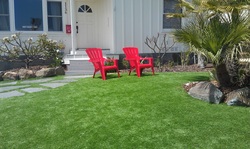 Relaxing in San Diego
Relaxing in San Diego When looking online for artist residencies, one is confronted with an overwhelming plethora of options. But how to distinguish "good" from "bad" ones?
Interestingly, despite the number of options, there are hardly any residency reviews to be found. There is one new website, ratemyartistresidency.com, that, once more people submit their experience, sounds like a promising resource. However, it will still only be one. Considering that most residencies last from two weeks up to several months and are not free, more information on what is to be expected should be available. The following are a two statements extracted from websites that highlight some positive and negative aspects of different residencies that I found after hours of research, indicating the utter lack of available information:
1. This summer, the Santa Fe Art Institute in New Mexico began a new family residency initiative, quietly but radically changing the landscape of access for artist-parents and creating an important model for other programs originally designed for single artists. On their site, you'll find the following statement:
The SFAI recognizes the lack of residency opportunities for artists to be able to take advantage of residencies without having to leave their children behind. We are taking responsibility in doing our part to close that gap by offering an environment that supports both creative opportunities and the needs of artists with children.
http://www.culturalreproducers.org/2013/08/family-residency-initiative-santa-fe.html
2. “I went to Elsewhere in Greensboro, North Carolina, this past summer as part of their first round of Southern Constellation Fellowship recipients. Southern Constellation is a newly created residency program that is funded through the National Endowment for the Arts. Each fellow receives housing, food, and an honorarium. This is a project-based residency, so residents are expected to create work in the space that responds to its archive of materials in some way. There are a number of people, referred to as “curators,” working at Elsewhere who manage different aspects of the space. There is a production curator who handles communication with the residents and ensures that they are undertaking projects that are in line with the mission of Elsewhere. This was an interesting residency. I am not a huge fan of very rustic living situations, so if the idea of living in an old thrift shop without air conditioning for a month and sharing a shower with 8 to 12 people is not appealing, I would not recommend this one."
http://burnaway.org/importance-residencies/
I think the SFAI approach deserves our attention and points in the right direction, though there is definitely still some way to go. On the other hand I wonder why we don not see loads of "rustic living"-style criticism. Why would artists accept the status quo just like that? Maybe because a residency is a potentially career-boosting entry on their CVs, and you wouldn't goof on that. And when you're over 35 ("emerging") and beyond "nomadic" romanticized artist lifestyle, you probably abandon residencies altogether.
So, rate your residency at www.ratemyartistresidency.com!
Interestingly, despite the number of options, there are hardly any residency reviews to be found. There is one new website, ratemyartistresidency.com, that, once more people submit their experience, sounds like a promising resource. However, it will still only be one. Considering that most residencies last from two weeks up to several months and are not free, more information on what is to be expected should be available. The following are a two statements extracted from websites that highlight some positive and negative aspects of different residencies that I found after hours of research, indicating the utter lack of available information:
1. This summer, the Santa Fe Art Institute in New Mexico began a new family residency initiative, quietly but radically changing the landscape of access for artist-parents and creating an important model for other programs originally designed for single artists. On their site, you'll find the following statement:
The SFAI recognizes the lack of residency opportunities for artists to be able to take advantage of residencies without having to leave their children behind. We are taking responsibility in doing our part to close that gap by offering an environment that supports both creative opportunities and the needs of artists with children.
http://www.culturalreproducers.org/2013/08/family-residency-initiative-santa-fe.html
2. “I went to Elsewhere in Greensboro, North Carolina, this past summer as part of their first round of Southern Constellation Fellowship recipients. Southern Constellation is a newly created residency program that is funded through the National Endowment for the Arts. Each fellow receives housing, food, and an honorarium. This is a project-based residency, so residents are expected to create work in the space that responds to its archive of materials in some way. There are a number of people, referred to as “curators,” working at Elsewhere who manage different aspects of the space. There is a production curator who handles communication with the residents and ensures that they are undertaking projects that are in line with the mission of Elsewhere. This was an interesting residency. I am not a huge fan of very rustic living situations, so if the idea of living in an old thrift shop without air conditioning for a month and sharing a shower with 8 to 12 people is not appealing, I would not recommend this one."
http://burnaway.org/importance-residencies/
I think the SFAI approach deserves our attention and points in the right direction, though there is definitely still some way to go. On the other hand I wonder why we don not see loads of "rustic living"-style criticism. Why would artists accept the status quo just like that? Maybe because a residency is a potentially career-boosting entry on their CVs, and you wouldn't goof on that. And when you're over 35 ("emerging") and beyond "nomadic" romanticized artist lifestyle, you probably abandon residencies altogether.
So, rate your residency at www.ratemyartistresidency.com!
 RSS Feed
RSS Feed
